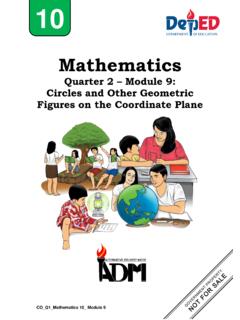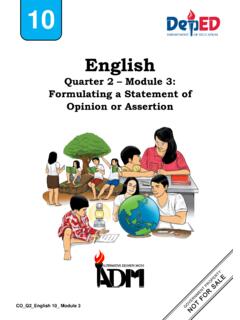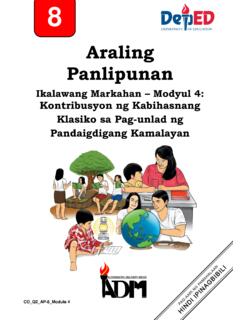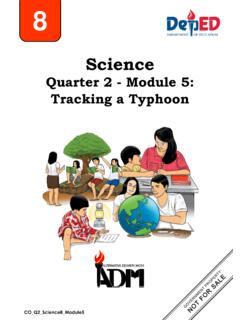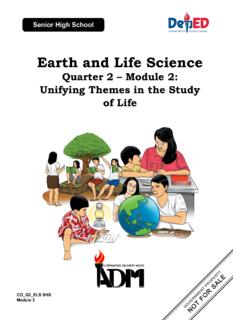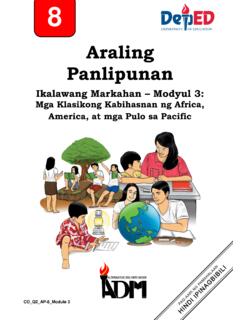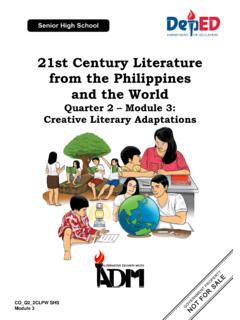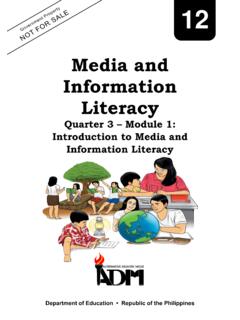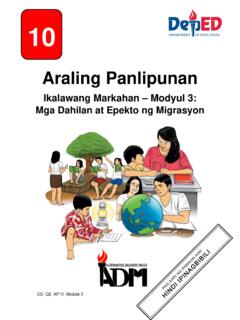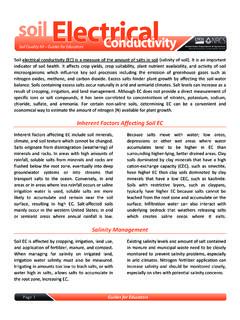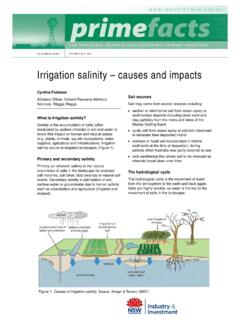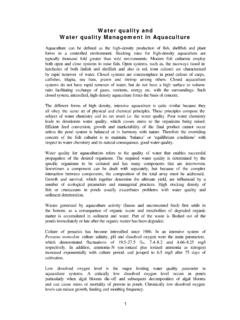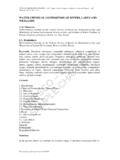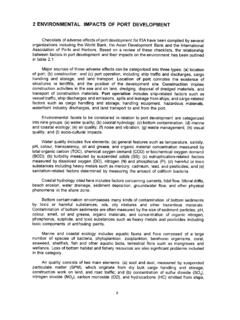Transcription of Quarter 2 Module 6: Estuaries and Intertidal Zones
1 CO_Q2_Science5_Module6 Science Quarter 2 Module 6: Estuaries and Intertidal Zones 5 Science Grade 5 Alternative Delivery Mode Quarter 2 Module 6: Estuaries and Intertidal Zones First Edition, 2020 Republic Act 8293, Section 176 states that: No copyright shall subsist in any work of the Government of the Philippines. However, prior approval of the government agency or office wherein the work is created shall be necessary for exploitation of such work for profit. Such agency or office may, among other things, impose as a condition the payment of royalties. Borrowed materials ( , songs, stories, poems, pictures, photos, brand names, trademarks, etc.) included in this Module are owned by their respective copyright holders.
2 Every effort has been exerted to locate and seek permission to use these materials from their respective copyright owners. The publisher and authors do not represent nor claim ownership over them. Published by the Department of Education Secretary: Leonor Magtolis Briones Undersecretary: Diosdado M. San Antonio Printed in the Philippines by Department of Education Region VIII Office Address: Government Center, Candahug, Palo, Leyte Telefax: (053)832-2997 E-mail Address: Writer: Editors: Reviewers: Layout Artist: Development Team of the Module Perpetua M. Fiel, Rachel E. Oronia Rex Briones, Ronald R. Cabigon, Mary Ann T. Garado Vera Leonora B.
3 Balasanos, Maribel Ponferrada, Rose Naomi C. Landagan, Rhodora A. Borja, Jocelyn D. Poli o, Dennis V. Bondos Ismael T. Posion, Bella C. Alberca, Henrissa M. Sible, Ryan R. Tiu, Paolo John a Management Team: Ramir B. Uytico Arnulfo M. Balane Rosemarie M. Guino Joy B. Bihag Ryan R. Tiu Rowena T. Vacal Manuel P. Alba o Henrietta T. Managbanag Sherlita A. Palma Felicidad T. Espinosa Ismael T. Posion Mauricio M. Catan Socorro B. Ausa 5 Science Quarter 2 Module 6: Estuaries and Intertidal Zones ii Introductory Message This Self-Learning Module (SLM) is prepared so that you, our dear learners, can continue your studies and learn while at home. Activities, questions, directions, exercises, and discussions are carefully stated for you to understand each lesson.
4 Each SLM is composed of different parts. Each part shall guide you step-by-step as you discover and understand the lesson prepared for you. Pre-tests are provided to measure your prior knowledge on lessons in each SLM. This will tell you if you need to proceed on completing this Module or if you need to ask your facilitator or your teacher s assistance for better understanding of the lesson. At the end of each Module , you need to answer the post-test to self-check your learning. Answer keys are provided for each activity and test. We trust that you will be honest in using these. In addition to the material in the main text, Notes to the Teacher are also provided to our facilitators and parents for strategies and reminders on how they can best help you on your home-based learning.
5 Please use this Module with care. Do not put unnecessary marks on any part of this SLM. Use a separate sheet of paper in answering the exercises and tests, and read the instructions carefully before performing each task. If you have any questions in using this SLM or any difficulty in answering the tasks in this Module , do not hesitate to consult your teacher or facilitator. Good luck and happy learning! CO_Q2_Science 5_ Module 6 1 What I Need to Know Estuaries and Intertidal Zones supply essential foods for all living things. The living or biotic factors like plants, animals, and microorganisms affect the ecosystem that includes coral reefs, salt marshes, mudflats, rocky shores, and mangrove forests.
6 This Module will help you understand better how organisms interact with one other to survive in Intertidal Zones and Estuaries . The Module is divided into two lessons, namely: Lesson 1: Interactions among living things and non-living things in Estuaries Lesson 2: Interactions among living things and non-living things in Intertidal Zones At the end of this Module , you will be able to: identify the biotic and abiotic components in Estuaries identify the biotic and abiotic components in Intertidal Zones explain how these components interact with each other for the survival of organisms in estuarine and Intertidal zone ecosystems Note: Use a separate sheet for your answers in all the activities in this Module CO_Q2_Science 5_ Module 6 2 What I Know Directions.
7 Match the descriptions in Column A with the correct terms being described in Column B. Write your answers on your answer sheet. A B 1. It is the amount of salt in water. A. soil 2. It is the hotness or coldness of the water. B. Intertidal Zones 3. It is the type of water in Estuaries . C. mangrove forests 4. These are the living components in the ecosystem. D. salinity 5. It is the area where the sea meets the land between E. coral reefs high and low tides. F. brackish 6. These are non-living factors in the environment. G. biotic 7. It is a source of nutrients for living organisms like plants. H. Estuaries 8. It is an area where the river meets the sea. I. temperature 9. It provides shelter to thousands of fishes.
8 J. abiotic 10. These serve as breeding grounds for organisms in Estuaries . Lesson 1 Interactions Among Living Things and Non-living Things in Estuaries Estuaries , like any other ecosystem, consists of biotic and abiotic factors. The biotic and abiotic factors or components of estuarine ecosystems interact in such a unique way, thus make some organisms choose to reproduce in these areas. For such reason, Estuaries are also called nurseries of the seas. The biotic factors are living things which include plants, animals, and microorganisms, while biotic factors are the non-living things found in the ecosystem. In this lesson, you will learn about the different biotic and abiotic components in Estuaries , their interactions, and their importance.
9 3 CO_Q2_Science 5_Mod 6 What s In Directions: Read the poem and make a list of biotic and abiotic factors mentioned by the author. Make a table like the one below on your answer sheet where you can write your answer. Biotic Factors Abiotic Factors AMAZING ECOSYSTEM Author: Rachel E. Oronia Sunlight, soil, waves, temperature, nutrients, & salinity Are abiotic factors affecting organisms survival in estuarine ecology Sunlight helps them grow, it aids plants photosynthesis It secures animal growth and plants food-making process Nutrients and minerals from soil keep plants healthy Organisms keep up with temperature changes though oceans are wavy salinity in Estuaries is also a great need For organisms to survive and feed 4 CO_Q2_Science 5_Mod 6 What s New Directions: Identify the biotic and abiotic factors found in the picture.
10 Make a graphic organizer on your answer sheet like the one below where you can write your answer. Biotic and Abiotic Factors in an Estuary Figure 1 (Pogoy,Charlito Louis S. nd) Estuary consists of c Biotic Factors (Living Components) Abiotic Factors (Non-living Components) 5 CO_Q2_Science 5_Mod 6 What Is It What are the biotic and abiotic components in Estuaries ?
